July 16, 2008
Port Resolution, Tanna Island, Vanuatu

We have been in Port Resolution, Tanna Island, Vanuatu for only 48 hours and have had more adventures than in the prior month. We arrived here after a rollicking sail from Fiji and a rather scary entrance through a narrow pass into this bay. The pass was scary not just because of the big seas breaking on rocks and reefs but also because it is so badly charted that it looked like we had to sail onto a high hill (according to the chart) to get into the bay. A 50 foot Beneteau sloop was famously lost on the reef here 4 years ago, so we were a bit anxious. Someone said that the chart is based on that prepared by Captain James Cook when he was the first European to visit Tanna in 1774. There is a famous painting of Captain Cook coming ashore in this bay to meet the locals. The bay is named after his vessel, HMS Resolution. When HMS Resolution left here, she went southeast and discovered New Zealand.
Captain Cook stopped here because he saw a great glow in the sky and wanted to investigate. The glow was the Yasur volcano that towers over this bay, and the volcano is still erupting. More on that later. Some decades later Cook was followed by missionaries. The locals preferred to cook and eat the first few sets of missionaries. Cannibalism in Vanuatu ended finally in 1969. The island population is split among three main groups, Christians, Kastom (customary ways except cannibalism), and John Frum (a cargo cult).
Port Resolution is a fairly small bay with a black sand bottom. On the shore just 50 meters behind Sabbatical III, steam and hot water comes boiling out of the rocks. You can swim close by and a have a very warm soak but the flow of hot water is variable and it can get too hot. Another volcanic vent just above the shore regularly puffs out steam. When Captain Cook anchored here in 1774, the bay was significantly deeper. The volcano caused the shallowing mostly through uplift (primarily in1928), not volcanic deposition.
Early yesterday, our first morning here, we picked up the Vera’s in our dinghy and motored our way to shore. We had to pick our way through rocks and reefs to find a beach on which we could land. A steep path took us up to the “Port Resolution Yacht Club.”
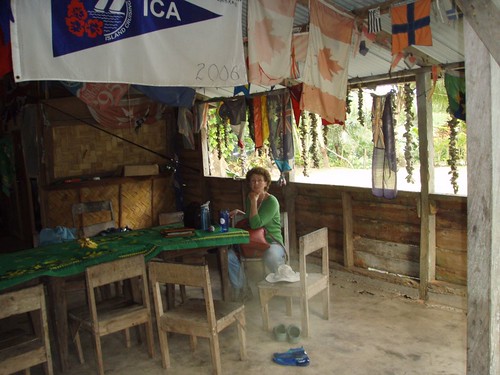
It is not a yacht club in the usual sense. It is a pavilion with two walls and a roof that was set up by the village of Port Resoluton to help the visiting yachties interact with the traditional culture of Tanna. We found Wery, who is the person designated to talk to yachties, to arrange transport across the island to Lenakel, where one could check in. Wery said that he would have a pickup truck available to take us the next day (today). He said that there was a wedding celebration in the village and we were welcome to walk around and watch. Before heading off for the village 500 meters away, we told Wery we would like to have lunch in one of the small very informal island restaurants. You need to give them at least a half a day’s notice (presumably to find some food to serve you).
The wedding celebration had started the day before but yesterday was supposed to be the big day. In the morning there was a formal ceremony in which the couple was presented with gifts, lots of pots,pails, and washbasins. At noon, we were then led through a narrow path across the peninsula to a small hut on stilts overlooking the crashing ocean surf. Some young girls from the village scooted by us in the path carrying pots and trays with food, which it turns out was our lunch. They set out a buffet lunch of rice, taro root, manioc, sweet potato, some other tubers, island cabbage, bread, “shoo-shoo” (a green vegetable), bananas, and chicken curry. It was a huge amount of food for the four of us,and we loved it. We sat on a low bench in the hut and ate our fill.

We returned to the village and found that the dancing had begun. It started off slowly but the tempo was building as the afternoon progressed. We took photos and videos and chatted with Wery’s sister Esther. The dancers were of all ages but danced separately by sex. Most wore t-shirts with colorful grass skirts. The bride had feathers in her hair and white powder on her face. The wedding party sat under a canopy of palm fronds, and sometimes the dancers danced in a circle around the canopy. They also did a line dance that looked like the hora. By late afternoon we were feeling a bit sunstroked and dehydrated, and returned to our boats. We were told that the dancing would intensify and go on through the night. We thought of returning in the evening but could not see how we could navigate the dinghy to the beach in the dark.

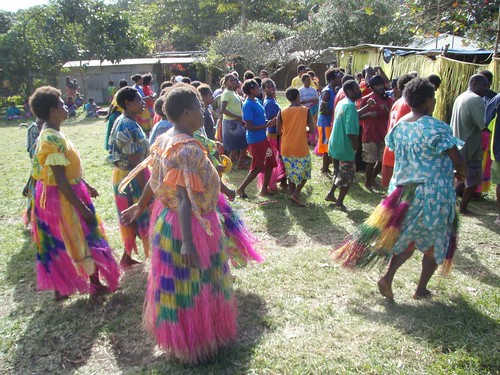
This morning we were us at 5 am in order to take the truck to Lenakel. The truck was an open pickup with no shade and hard benches 9 inches wide along the bed.
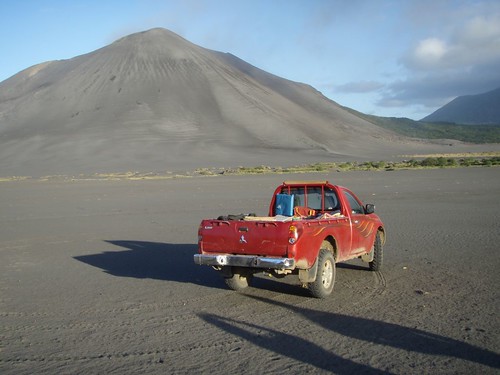
Forewarned of this, we brought sun shirts and cushions. We also brought jackets and warm tops since we would have to climb over Mt. Yasur to get to the west coast of the island where Lenakel is located. Lenakel is the capitol city of the southernmost province of Vanuatu, encompassing a number of islands in addition to Tanna. It has a customs office and an immigration office, as well as a market and some small stores, in a city of nearly 1000 people. Joining Vera and us were David and Mary, two retired doctors from Victoria, Canada. Victoria has a special relationship with Tanna. In particular, it supports the small hospital in Lenakel. David and Mary had boxes of medicines with them to deliver to the hospital that they brought from New Zealand in their sailboat.
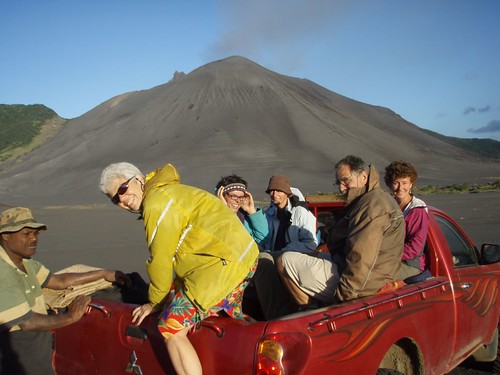
Stanley, the young son of the village chief of Port Resolution, came along to guide us. Stanley had been partying most of the night at the wedding and had drank 7 bowls of potent kava (kava in Tanna is said to be the most potent in the world), plus a bottle of vodka. He claimed that it was the vodka that did him in. He had returned to his home at 3:30am and his wife would not let him in his house. He slept on the ground for a couple of hours before meeting us at the pickup truck. He was very hungover. Fortunately, Stanley did not drive the truck. He did pass out at lunch and slept on the beach at Lenakel in the afternoon. When we returned to Port Resolution early this evening, his wife met the truck and angrily balled him out (in Bislama, the pidgin English national language). She was angry at his vodka binge the night before (not his kava drinking, since that is customary), and for forgetting to buy the things she asked him to get in Lenakel.

It was quite an amazing and scenic trip across the island. The road is just a track through the forest. You have to keep your head down to avoid getting whacked by a tree branch. The pickup truck bounces vigorously as it jumps over rocks and ruts. We climb up the forested slope of Mt. Yasur and had wonderful views in all directions. Suddenly, vegetation disappears and we drive in a moonscape of rocks, gullies, and crevaces. Finally, we cross below the volcanic cone, driving in ash, curving around large dunes of grey volcanic ash. Puffs of smoke and ash rise from the volcano’s cone. Two hours after we depart Port Resolution, we descend into Lenakel. Immigration and Customs are both extraordinarily efficient and friendly — quite unlike Fiji. There are simple forms and warm greetings. Receipts are provided without having to request them. Our doctor friends are dropped off at the hospital with their cartons of medicines, and the Sabbatical’s and Vera’s check out the market and find lunch. It was not a market day (those are on Friday and Monday), so there was not much for sale but we did get some avocadoes, pineapple, peanuts, lemons, and ginger. Bananas are not for sale since they are everywhere and in every yard, so who would ever buy them, except the odd yachty?
Stanley came along with us to a small restaurant where the menu consisted of rice and beef or rice and fish, but they were out of fish. That made choosing so easy. Stanley was still feeling his hangover but did rouse himself when the food arrived. After lunch, we had 3 hours to kill until the pickup returned. There is not much to do in Lenakel and there was literally almost nothing on the shelves of the few small stores. We could not even find bottled drinks for sale. We hung out on the beach under a banyan tree and watched women strip bark off of branchs to make “grass” skirts. The trip back was somehow even bumpier than the trip out, but in the late afternoon light the scenery was even more spectacular. As we stopped beneath the volcanic cone, it gave a loud burp and puffed out a nice cloud.
When we returned to the boat, we were dehydrated, dead tired, and covered in volcanic ash. After a shower and quick dinner, I wrote the above and we headed off to bed. Stanley had invited us to a circumcision ceremony at the village at Black Sands, for the next day, but we could not see ourselves making the 7 am start. Now it is the next day (Thursday July 17), and we just returned from the circumcision ceremony. We went late but it did not matter, we were there for the best parts. It was quite extraordinary. The recently circumcised boys had painted faces, flower leis,colorful feathers in their hair, and other special attire, as did their families. There was joyful dancing, piles of taro and manioc, laplap, and the killing of pigs (the latter is what we missed by coming late). We gave a pair of new flip-flops as a gift, and received a large taro stalk. Six of the seven boats at anchor were present, and we were all treated as welcome guests. I took lots of photos and video. People do not mind having the photos taken if you first ask permission, and they love it when you show them the digital photo. The children scream with laughter.

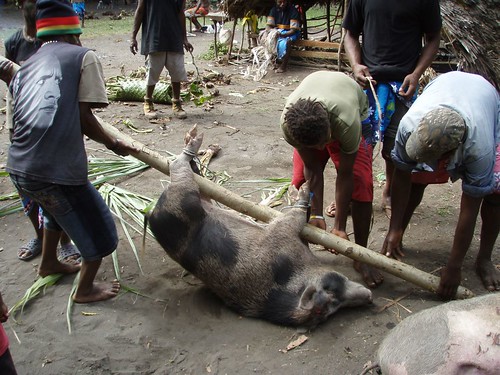
So it has been a very eventful two (now three) days. We have not had the opportunity to take down our spinnaker pole until just now, and boats chores have gone undone. But what can you do you do when the neighbors invite you to a wedding and a circumcision?
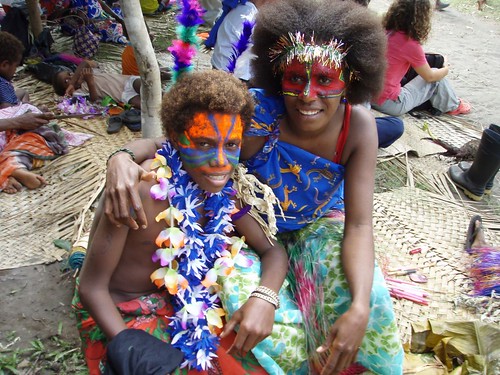
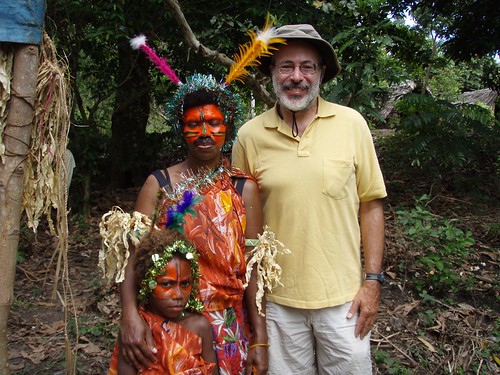
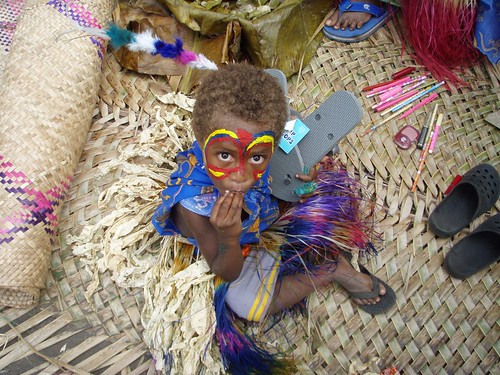
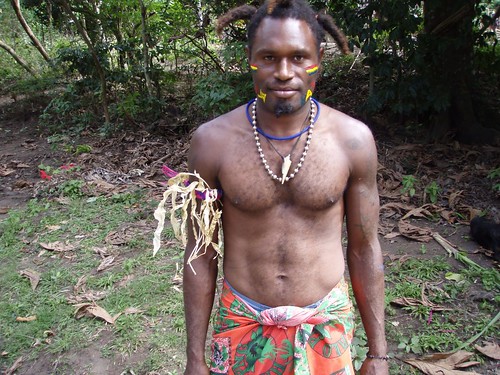


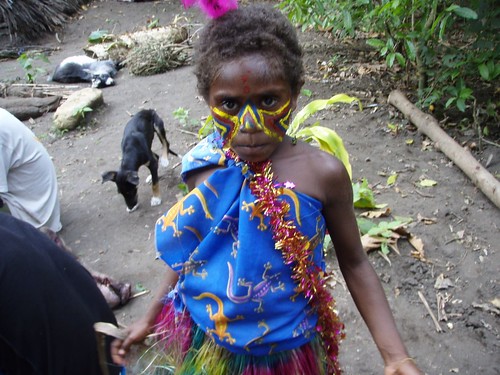
M.
